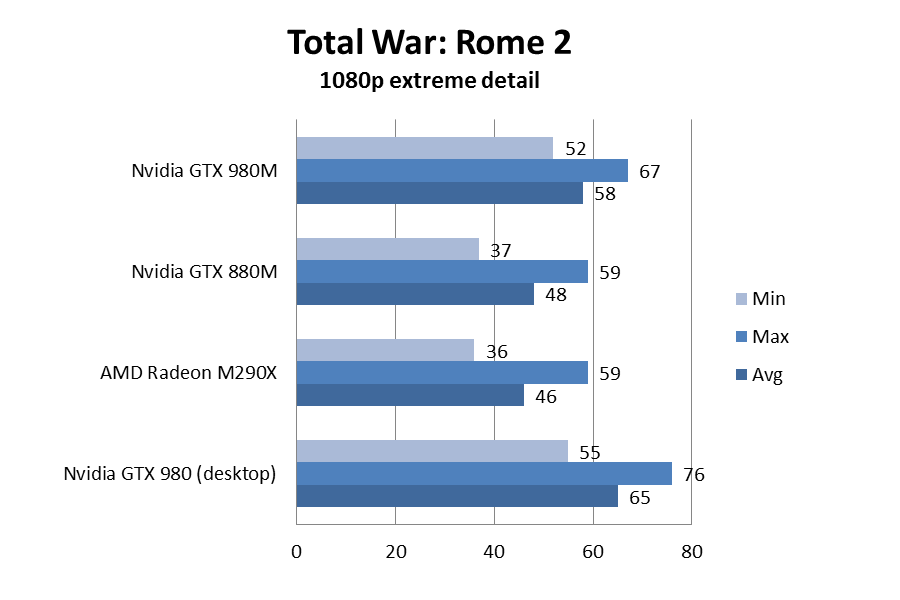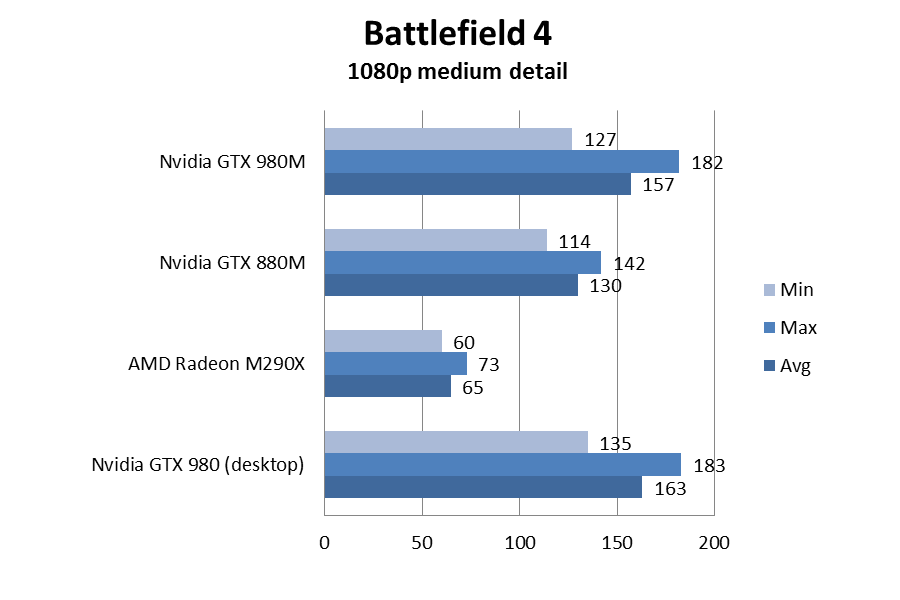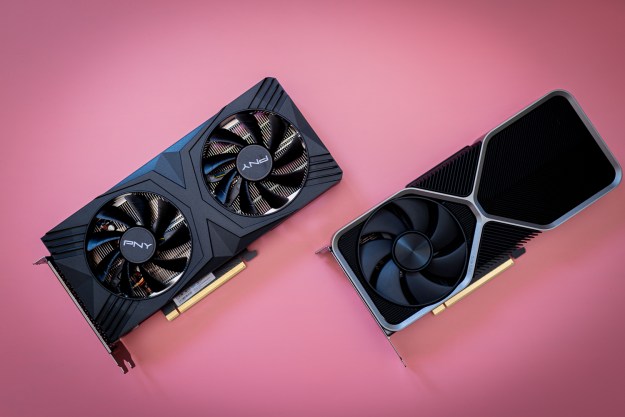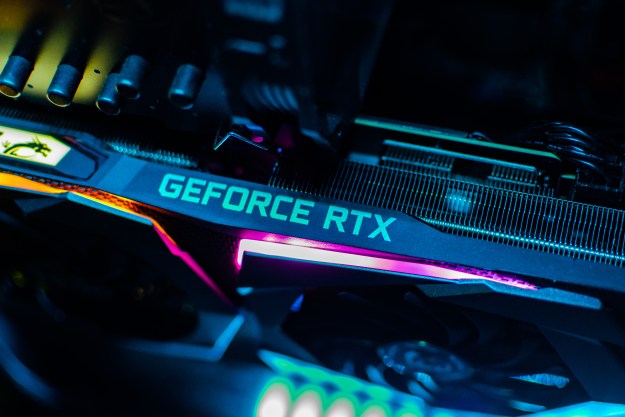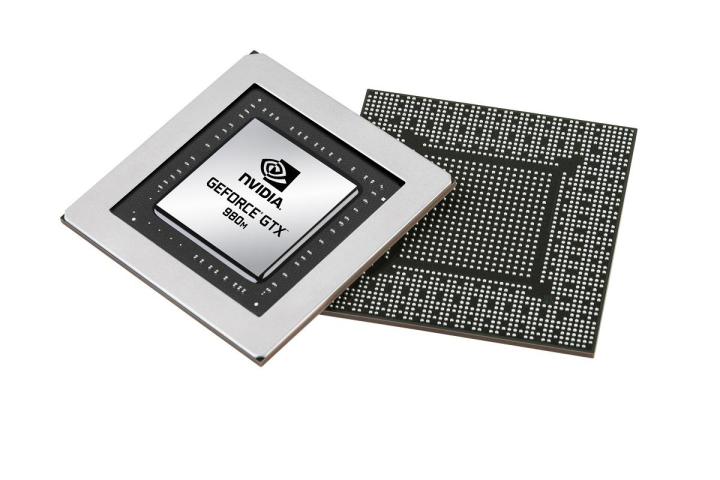
The card managed to beat the preceding GeForce GTX 780 Ti in most performance tests while also using roughly two-thirds the power. It’s rare to see new hardware slash power consumption that aggressively while still offering high-end performance.
This sort of efficiency is nice in a desktop rig, but it can be revolutionary in a laptop, and Nvidia hasn’t wasted any time bringing the same hardware to notebook PCs.
Toward that end, Nvidia just announced its new GeForce GTX 980M and GTX 970M GPUs, which are rolling out in laptop computers around the world right now.
Will these GPUs spur a revolution in gaming laptops?
A closer look at the GTX 980M
While both the 980M and 970M are arriving in laptops this week, our focus is on the most powerful of the pair. The GeForce GTX 980M will be the mobile GPU to have for at least the next year, barring a huge announcement from AMD in that time.
How well it does (or doesn’t) live up to expectations will be one of the biggest factors that determines the quality of the gaming laptops that are released between now and deep into next year.
Like its desktop-based cousin, the GTX 980M is built on Nvidia’s Maxwell architecture. Though it’s being released a few weeks after the GTX 980’s launch, the architecture was originally conceived as a solution for mobile rather than desktop systems. Power efficiency was a priority from day one.
Two major changes have been made to reduce power draw. The first is a re-ordering of execution units into smaller groups. This allows more control over how they’re activated, and how power is used.
The second is a boost of level two cache to 2MB, which slightly decreases the need to read from the card’s DRAM. These changes, along with various other tweaks, help Maxwell consume less power despite the fact that it’s built on the same production process as Kepler, its predecessor.
Nvidia claims that the GTX 980M is almost as powerful as its desktop counterpart, and the specifications indicate the same. The chip offers 1,536 CUDA Cores, and a base clock of 1,038MHz. The desktop card, by comparison, has 2,048 CUDA Cores, and a base clock of 1,126MHz.
The 980M also uses the same 256-bit memory interface and GDDR5 RAM, though the amount of RAM you get with the 980M may vary from one laptop to the next. Meanwhile, the 970M offers 1,280 CUDA cores, and a base clock of 924MHz.
On paper then, the GTX 980M is about 75 percent as powerful as the desktop card. It’ll be interesting to see how that translates to real-world gaming performance.
Packed with features
New graphics architectures usually improve performance, but there’s more to Nvidia’s latest hardware than raw numbers. Nvidia has added extras like Optimus, ShadowPlay, and GameStream over the years. These have helped give the green team a competitive edge over AMD, and Maxwell continues the assault by adding three new features to the list.
The most immediately useful newcomer is Dynamic Super Resolution. This renders a game at a resolution beyond the notebook’s display, and then scales the result down to fit.
This helps capture more detail than is possible when rendering the game at the notebook’s native resolution. DSR is demanding, so it’s not a good idea to enable it with the latest titles, but it can enhance the quality of older games that don’t strain the GTX 980M, even at their highest settings.
Nvidia has also added Voxel Global Illumination and Multi-frame Sample Anti-Aliasing, a pair of hardware features designed to improve image quality.
The former, which was used by the company to de-bunk conspiracy theories surrounding the lunar landings, allows real-time rendering of realistic light sources.
The latter is an anti-aliasing technique that uses multiple AA samples across multiple frames to achieve a quality effect with a lesser impact to performance. Both features hold promise, but they also require developer adoption, so you won’t see an immediate benefit.
Our test methods
We used the ASUS G751JY to test out the 980M. This is a system that’s rolling out alongside Nvidia’s GTX 980M/970M debut. Its specifications include an Intel Core i7-4710HQ processor, 24GB of DDR3 RAM, and a 1TB mechanical drive paired with a 256GB PCI Express solid state drive. Our full review of the notebook will be published later this week.
We rounded up two other notebooks for comparison. The AMD Radeon R9 M290X is represented by the Alienware 17, while the the GTX 880M is represented by the AVADirect Clevo P157SM. We selected these systems because they were reviewed with Intel processors that perform similarly to the ASUS G751JY.
The GTX 980 desktop card will be included in our results, as well. This is due to Nvidia’s claim that the new GTX 980M offers 75 percent of the desktop card’s performance. We’re eager to see if the mobile chip can make good on that claim.
All of the tests were conducted at 1080p resolution.
3DMark
We started with 3DMark, a synthetic benchmark that’s used to test desktops and laptops across the globe. It provides a good approximation of overall performance.
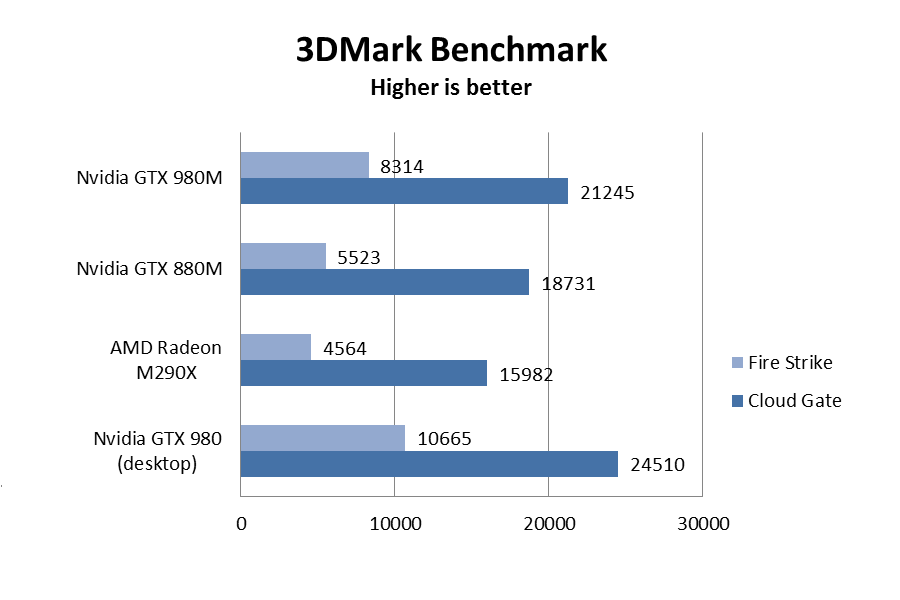
The latter is the more notable of the two, however, as the GTX 980M’s Fire Strike score of 8,314 is relatively close to the desktop GTX 980’s score of 10,655. In this benchmark, the laptop GPU offers roughly 3/4 of the performance that the desktop version does.
Rome II: Total War
Creative Assembly’s sprawling strategy game can place significant load on a video card due to its detailed terrain, and potentially massive battles. The GTX 880M was unable to play this game at 60 FPS with the game’s visuals set to Extreme. Does the 980M fare better?

 Battlefield 4
Battlefield 4
Though it’s no longer the hottest shooter out there, Battlefield 4 is still among the best looking ones you can get. It’s also one of the most demanding shooters too. This is another title the GTX 880M couldn’t handle at Ultra detail and 60 FPS. Does Nvidia’s new GPU do better?
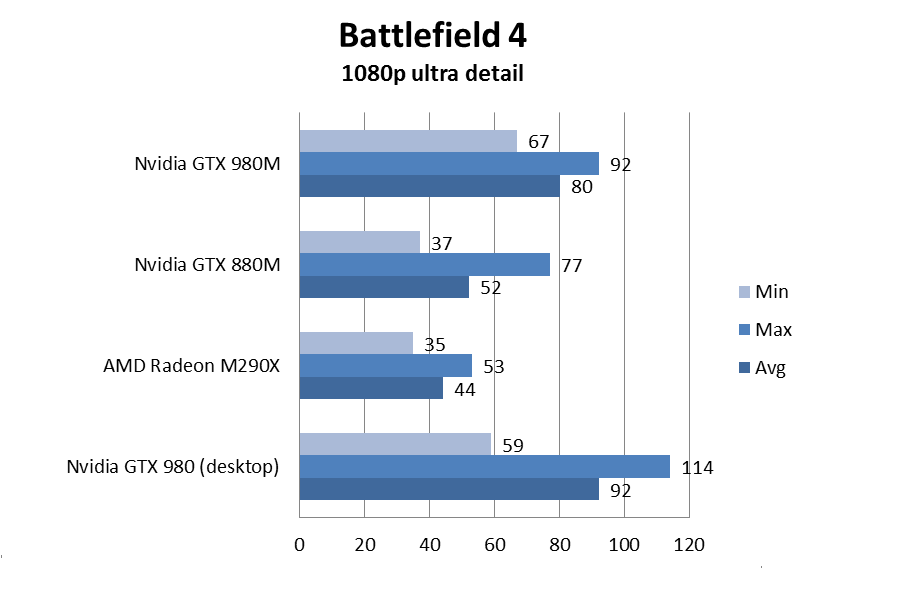
In this game, the new GTX 980M absolutely vaults ahead of the competition. Its average of 80 FPS at Ultra detail beats the GTX 880M’s average framerate by almost 30 FPS, and nearly doubles the performance of AMD’s Radeon R9 M290X. The victory couldn’t be more obvious.
 League of Legends
League of Legends
We wrap up our benchmarks with League of Legends. This incredibly popular game isn’t much of a challenge for high-end GPUs, but it benefits from the smooth gameplay that extremely high framerates provide.
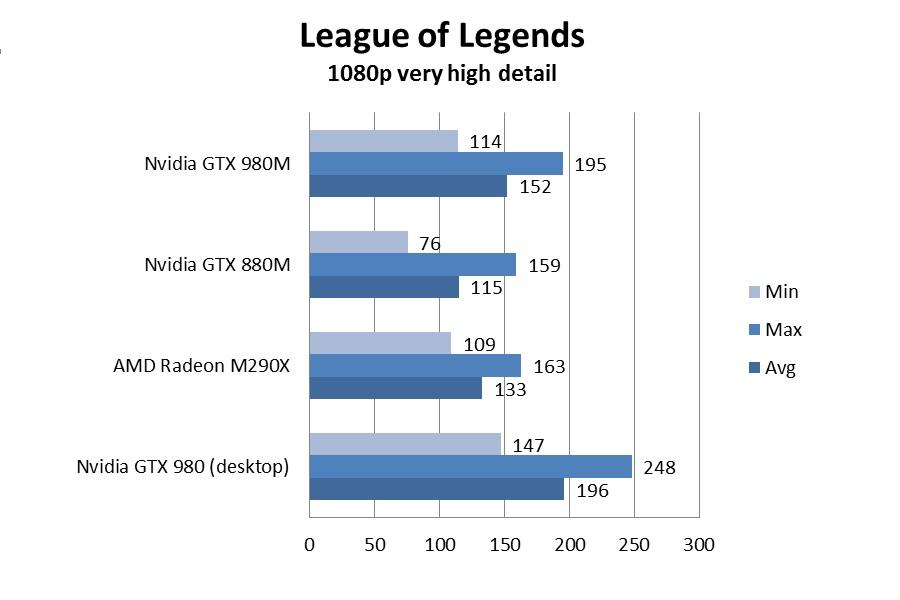
The entire field is more than capable of playing this game at over 100 FPS with detail set to Very High. The GTX 980M is better than the rest, however, as its average of 152 FPS is almost 20 FPS better than the Radeon R9 M290X, and almost 40 FPS better than the GTX 880M. The desktop GTX 980 still leads the pack, but the 980M once again offers more than 75 percent of its performance.
Performance conclusions
The GTX 980M offers a major improvement over the GTX 880M and Radeon R9 M290X in every benchmark we used.
Comparing the mobile GPU to its desktop counterpart also leads to a favorable conclusion. Nvidia told us to expect about 75 percent of the GTX 980’s performance in the 980M. The GTX 980M consistently held up to that claim.
In Total War: Rome II, it managed an incredible 89 percent of the desktop card’s performance. At its worst, it still slightly exceeded the 75 percent claim.
Power draw
As we mentioned earlier, the GTX 980M supports Nvidia Optimus, a graphics switching technology that hands the graphics over to Intel’s IGP when a game or other 3D application isn’t open. This means that consumption under gaming load is the only relevant figure.
Our wattmeter recorded the ASUS G751JY using an average of 183 watts during our 3D stress test. That’s more than the AVADirect Clevo P157SM, which needed 157 watts, or the latest Alienware R17, which ate 156 watts.
This result seems odd given Maxwell’s focus on efficiency, but it makes sense in light of the performance results.
Nvidia spoke highly of the GTX 980M’s performance relative to its desktop variant, but didn’t talk much about efficiency or power savings.
In most situations, an improvement in efficiency is used to deliver a reduction in power draw, but it can instead be used to increase performance within an existing power envelope. The GTX 980M takes the second route.
Whether this is the right approach is up for debate. Going for performance makes games look and play better, but also means that high-end gaming notebooks will continue to be massive, unwieldy bricks. Gamers who want a more balanced combination of portability and power should wait for the inevitable GTX 960M.
Conclusion
The GTX 980M’s release marks a major step forward for notebook gaming. It’s much more powerful than the GTX 880M or Radeon R9 M290X, and comes surprisingly close to its desktop-based cousin in most titles. Gamers have to sacrifice less to game on the go.
Plus, there’s more to the GTX 980M than performance. The chip retains all of the features offered in previous Nvidia notebook GPUs, and adds three more, one of which (Dynamic Super Resolution) is immediately usable.
Power draw is the only disappointment. We thought the GTX 980M might pave the way for thinner, lighter notebooks, but it doesn’t look like that will be the case. Nvidia’s decision to push the limits of notebook graphics means gamers must continue to put up with bulky, heavy systems.
Still, anyone with a GTX 500M or 600M-powered notebook should keep an eye on newly released laptops with Nvidia’s GTX 980M/970M GPUs in them.
These components will easily offer double the graphics performance of notebooks that are more than two generations old. They’ll also provide access to new features, and better battery life as well. Nvidia’s GTX 980M is the perfect GPU for any mobile gamer looking to upgrade.
Editors' Recommendations
- Let’s create: Why NVIDIA Studio laptops are quintessential for content creators
- Nvidia’s peace offering isn’t working
- Nvidia’s RTX 4060 might not be such a disappointment after all
- AMD might crush Nvidia with its laptop GPUs — but it’s silent on the desktop front
- Here are 5 GPUs you should buy instead of the RTX 4060 Ti

